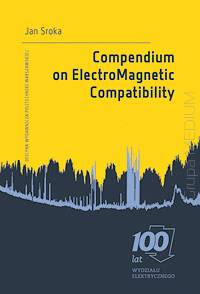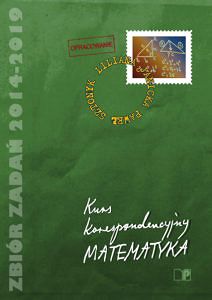Compendium on ElectroMagnetic Compatibility
- Dodaj recenzję:
- Kod: 4846
- Producent: Oficyna Wydawnicza Politechniki Warszawskiej
- Autor: Jan Sroka
-
-
Najniższa cena 30 dni przed zmianą: 43,00 zł brutto
- szt.
- Cena netto: 46,67 zł 49,00 zł
Compendium on ElectroMagnetic Compatibility
rok wydania: 2021, wydanie pierwsze
ISBN: 978-83-8156-276-8
ilość stron: 212
format: B5
Opis
Electromagnetic compatibility is a capacious branch. This book is not claiming to cover all aspects of it. It is rather a narration about EMC from the sight angle of professional experience of the author, and it is versatile. At the origin, it was a scientific activity with numerical methods and simulations of electromagnetic fields at the WUT and teaching about theory of electromagnetic fields and electrical circuits
Spis treści
Foreword / 9
1. Fundamental terms, definitions and tools / 13
1.1. Electromagnetic environment / 13
1.1.1. Perception and consequences of embedding in the environment / 13
1.1.2. European regulation relating to electromagnetic compatibility / 16
1.2. dB, or not dB, that is the question / 19
1.2.1. Floating decibels / 19
1.2.2. Bonded decibels / 21
1.3. Electrical dimension / 23
1.4. Power (impedance) matching / 25
1.5. Scattering matrix / 30
1.5.1. Insertion loss versus voltage loss / 31
1.5.2. Derivation of a one-port impedance / 33
1.6. Modal description of transmission lines / 35
1.6.1. Delta-T transposition / 35
1.6.2. Modal circuit / 36
1.6.3. Decomposition of currents in multiwire lines / 39
1.7. What actually R, L, C one-ports are? / 40
1.7.1. Wire wound resistor / 41
1.7.2. Metal film resistor / 42
1.7.3. Film capacitor / 43
1.7.4. High frequency choke / 44
1.8. In bush of the pulse parameters / 45
1.8.1. Measurable pulse parameters / 46
1.8.2. Calculable pulse parameters / 46
1.9. Waveforms in the time and frequency domain / 47
1.9.1. Fourier series / 47
1.9.2. Fourier integral / 50
1.9.3. Amplitude Modulation / 50
2. Low-frequency current and voltage disturbances / 55
2.1. Current harmonics / 56
2.2. Flicker / 57
2.3. Characteristic of main’s voltage / 60
2.3.1. Harmonics / 60
2.3.2. Unbalance / 61
2.3.3. Dips and interruptions / 63
2.3.4. Commutation notches / 64
2.4. Solar storm / 65
3. Radio-frequency electromagnetic disturbances / 69
3.1. Sequence of toggled DC voltage / 69
3.1.1. Rectangular waveform / 69
3.1.2. Pulse modulation, radar pulsing / 72
3.1.3. Trapezoidal waveform / 74
3.1.4. Damped oscillatory waveform / 77
3.2. Single events – pulses / 80
3.2.1. Electric discharge in gases / 80
3.2.2. Spectral density of triangle pulse / 84
3.2.3. Discharge of static electricity / 86
3.2.4. Electric fast transients BURST / 90
3.2.5. Lightning discharges / 92
3.2.6. Nuclear/High-altitude ElectroMagnetic Pulse / 97
3.3. Relevance of the frequency bandwidth BW / 101
4. Propagation of disturbances / 103
4.1. Examples of unsymmetrical and symmetrical transmission / 104
4.2. Galvanic coupling / 106
4.2.1. Internal impedance of round wire / 108
4.2.2. Internal impedance of conductor with rectangular cross section / 111
4.2.3. Precedence of rectangular over round wire common return path / 113
4.3. Electric (capacitive) and magnetic (inductive) coupling / 115
4.3.1. Capacitive coupling / 115
4.3.2. Inductive coupling / 116
4.3.3. Dependence of capacitance and external loop inductance on cross section’s shape / 117
Capacitive and inductive coupling by symmetrical transmission / 119
4.3.4. Transverse to longitudinal conversion / 120
Decomposition of currents into common and differential mode / 122
4.4. Wave coupling / 124
4.4.1. Radiated waves / 124
Idealized entities as elementary radiators / 124
Field probes / 129
Antennas / 131
Reciprocity theorem / 149
Unintentional antennas / 150
4.4.2. Guided waves / 152
5. Protection from disturbances / 157
5.1. LF filtering / 157
Passive filters / 157
Active filters / 159
5.2. RF filtering / 160
5.2.1. Overlying the useful voltage with disturbances / 160
5.2.2. Ingredients of filters / 162
5.3. Non linear suppressors / 169
5.4. Shielding / 173
5.4.1. Static and quasi-static fields / 174
Metal shields / 174
Shielding with diamagnetics and ferromagnetics / 177
5.4.2. RF shielding in the far field zone / 179
Feed-throughs and apertures in RF shields / 188
5.4.3. Cable shielding / 189
5.5. Miscellaneous / 193
5.5.1. Potential bonding vs. galvanic separation / 193
5.5.2. Cable shield termination / 195
5.5.3. Cabling with improved electromagnetic compatibility / 196
Twisted pair / 196
Ribbon cable / 198
Cable layout / 198
Bibliography / 201
List of abbreviations / 205
Index / 207


